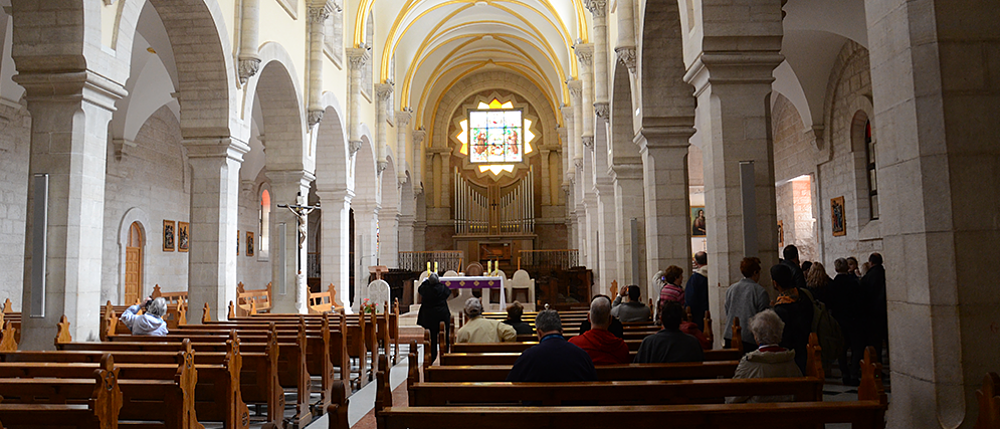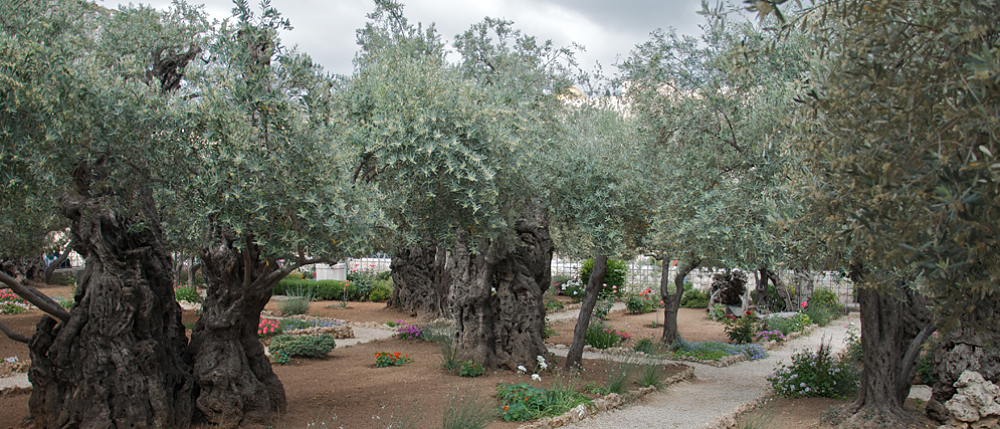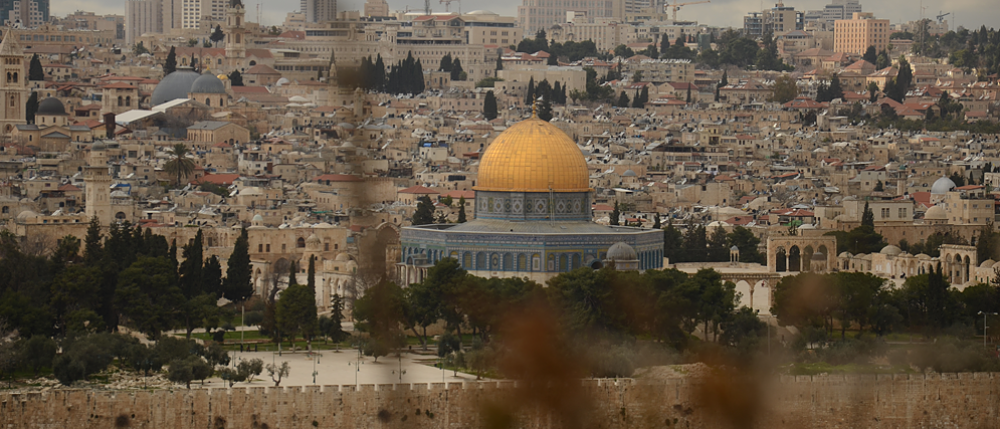Why Take a Pilgrimage to the Holy Land?
Rev. Dr. Donald Allston Fishburne returned from the Holy Land and wrote these articles to provide a fresh perspective on why travling to the Holy Land is such an important aspect to any clergy's personal and professional development as well as the life of a congregation.
Why Clergy Should Make Pilgrimages to the Holy Land
I’ve encouraged seminarians to make pilgrimages to the Holy Land; I have even helped them find funding for their journey. Without exception they tell me it has added new dimensions to their theological education and understanding – and to their ministries of teaching and preaching. I somehow never found the time and money for a Holy Land pilgrimage in my 35 years (so far) as an ordained minister serving congregations – until now. I wish I had made at least one years ago; multiple pilgrimages with different emphases would have been even better. There is nothing like walking where David and Solomon walked and imagining the lives of Abraham and Sarah, Moses and Elijah. Walking where the Holy Family lived, struggled, walked and rejoiced. And walking the way Jesus walked in life, and to his cross. Standing at the site of the Temple, and hearing his teaching with new ears. Being on mountaintops, at the sea, in the villages and towns where he was born, grew up, taught, healed, and cared for God’s people. There’s nothing like it. There is no substitute for the experiences of being among the people of the land, in the Holy Land, journeying where Jesus and his disciples journeyed, where the apostles gathered and ministered, where Saul became Paul and changed the world. I’m still trying to understand how the people of that region get along – and don’t get along. We know the descendants of Abraham struggled to live together in ancient times. And how they try to do so in our own day – fishermen, merchants, Arab Bedouin nomads in the Negev and the Galilee – and these days – employees of the world’s high tech industries living and working in the international cities of Tel Aviv and Jerusalem. In Bethlehem I opened a conversation with a street merchant who had grown up as a Christian in Haifa on the coast – a bustling seaport. Life is hard, and living with checkpoints is more than worrisome. It is possible that there will be no Christians in Bethlehem in the future –and that would be a very sad thing. Christian pilgrims from North America and elsewhere – clergy and laypeople – can help build bridges of understanding – and can help support Christians in the Holy Land. It is worth the effort.
Browse through our journeys to the Holy Land.

Thinking of visiting the Holy Land?
Make it a pilgrimage – more than a trip
A faith pilgrimage to the Holy Land is a life-changing event for clergy and lay people.
Though it is possible to visit Israel only for a vacation or for business, don't miss the opportunity to make a spiritual pilgrimage to holy sites. It's much more valuable than traveling as a tourist.
My recent experience is that a pilgrimage by clergy with the companionship of lay people is rewarding beyond all my expectations.
Eyes are opened, faith partnerships are strengthened -- and we will never read the Bible in the same way again.
For me, some of the wonder of the pilgrimage is to walk where Jesus walked -- and to understand that some parts of his journey were accomplished in only minutes or a few hours, while others, including going up to Jerusalem, would take days with stops along the way. Studying Scripture and having a mental picture of this is one thing – to go to the place Jesus was born, and the place where he spent his last night before the crucifixion, and to walk where he walked – all of these experiences bring his story alive for us in new ways. Likewise, to go to the Jordan River where John baptized Jesus, and to Jericho, Nazareth and other holy places we have heard and read about helps us understand what the first followers of Jesus would have experienced.
To hear the Sea of Galilee called the sea of life, while praying quietly on a boat on that sea, is unforgettable. It is good to get a sense of how far is it from the Dead Sea, and to know the difference in the landscape and way of life in different regions. Some valleys are verdant; some places are inhospitable wildernesses.
How would the people of Jesus' day experience God at work in those waters, those hills and valleys, and in the neighboring communities?
On our recent flight from New York to Tel Aviv, it was obvious that many of the travelers were from a variety of expressions of religious Judaism. Some were going to Israel to visit family members, and others, alone or in groups, were making their own pilgrimage to ancient holy places, so that the stories about God at work through the lives of their ancestors and their contemporaries would be enriched.
It is stunning to experience in Israel and the West Bank of Jordan how closely Christians, Jews and Muslims live together. Churches, mosques and synagogues are frequently in sight of each other.
It is a faith journey experience to realize the difficulties of people of faith living alongside each other – and it is a particular joy to see how, with prayer and attention, these relationships can be rich and respectful, not filled with discord or enmity.
Holy things held in common – or dividing walls
It is a wonderful thing to make pilgrimage to the likely site of Jesus' baptism -- and a tragic thing to have to pass close by minefields installed years ago by the Israeli military in times of heated border conflict. How terrible a thing it is to experience first hand that politics and religion clash in history. How wonderful it is to visit the Star of Bethlehem in the Church of the Nativity – but how wrenching it is to have to pass through a dividing wall and checkpoint between Jerusalem and nearby Bethlehem. "The wall will not stand forever," a Palestinian Christian in Bethlehem tells me.
There is the hope of lively faith.
Giving Thanks for a Gift by Paying It Forward
A Spiritual Pilgrimage to the Holy Land – At the Right Time.
My wife Sarah and I are grateful for the privilege of a spiritual pilgrimage to the Holy Land. It has changed us. Somehow it never before seemed to be the time, earlier in my vocation as a clergyperson and in our lives as husband and wife. The children were too young, or I was accepting a new call, or we did not think we had the time or the money. A combination of prayers and gifts and discounts changed that, and at the urging of those who had made such pilgrimages we set out for the Holy Land – with my brother and one of his adult daughters. We’re grateful to have walked on holy ground and to have had our Christian faith enriched – even if we never get to go back. But having been changed, of course we want to share the gift and the experience by helping others make similar pilgrimages of faith.
A pilgrimage – not just a trip
What’s different for us? We have new eyes with which to read Scripture and to see through the lens of Scripture. We have better understanding of people of Abrahamic faiths – two thousand years ago, ages before that – and in our present-day world. Before we went I asked a younger clergy friend why he would be going soon. A number of members of his congregation had been, he said, and they expected that he would be able to see the Holy Land through experiences similar to their own. I also had conversations with another clergyperson who had lived and ministered in Jerusalem for years, and his witness compelled me to go. On our pilgrimage we met up with a friend who was in Jerusalem while we were – leading his third congregational pilgrimage. In his blog he wrote the next day, “We Holy Land pilgrims are preparing to leave the holy city of Jerusalem, some of us flying home, some of us heading into Jordan for a couple of nights. And our journey has indeed been a holy pilgrimage: walking – as the saying goes – in the footsteps of Jesus, reading Scripture along the way, and praying. And looking out over the landscape. And learning. And laughing. And sighing, with hearts aching. And listening, and watching, and asking questions. And being quiet. And praying some more. And then praying some more. And being quiet some more. We'll never hear the ancient stories the same way again. And something has happened in us... And I hope you too will make a pilgrimage to the Holy Land. Our Islamic sisters and brothers have something to teach us about the power of pilgrimage. It was a part of our tradition long ago, but we Christians generally... are in need of reclaiming it. I give deep thanks that this is the third Holy Land pilgrimage from St. Paul's Church (Richmond) in just five years, and that we are planning on another in 2018 when we will be present in the Church of the Resurrection / Holy Sepulchre in Jerusalem for Orthodox Easter. I rejoice over what has already gotten into the spiritual bloodstream of St. Paul's through these holy experiences, and I celebrate that there will be more pilgrimages to come.”
Changing the lives of church membersOn our pilgrimage I asked some lay leaders in our tour group for their thoughts:
“I wish I could have seen the Holy Land when I was younger.” “The trip helped me picture the places mentioned in the Bible and gives me a better understanding of how people were living and what they were facing there 2000 years ago.” “I was surprised by the large amount of high tech industry in Israel... I admire the Jewish people for a lot of reasons. In two generations they have turned a backward, agricultural country into a modern, relatively self-sufficient country. They did this in the face of deadly hostility from their neighbors and others. Their toughness, resourcefulness and ingenuity are remarkable.” Another clergy friend who has taken groups of writes, “The pilgrimages to the Holy Land I’ve been privileged to take over the course of my ordained ministry have been life- transformative. To travel the road of our forebears, including for Christians, the journeys of Jesus, makes our story come alive, and enables us to appropriate the compelling tenets of our faith in the world in which we live."
Imagine your spiritual pilgrimage to the Holy Land
Imagine planning your spiritual pilgrimage. If you are a clergyperson, it will enrich your faith, your teaching and preaching, and your understanding of ancient history and contemporary issues in faith, religion and politics – especially if you make your pilgrimage journey in the company of members of your congregation or community of faith. In your time of preparation you may reread Scripture to embrace your planned itinerary – but be prepared to be surprised at how quickly your perspective changes when you arrive at holy places you’ve read about for years. Your guide to those places will almost certainly point out that almost everywhere you set foot in Israel and the surrounding regions can be considered to be holy ground.
Think about this as one possible itinerary for you and members of your family and congregation:
Arrival and customs check-through at Tel Aviv airport (or the port of Haifa) is quick and easy. In a year or so there will be a high-speed train to Jerusalem. Your first day might begin in Jerusalem – or, alternatively, at Nazareth. There you would stand on Mount Precipice and realize that it is from this cliff that a wayward crowd thought of hurling Jesus over the side after he spoke of fulfilling the prophecy of Isaiah. (Pope Benedict XVI led 400,000 pilgrims in 2009 to the area “where it all started.”) Mount Tabor is in view as you see the panorama that includes the Jezreel Valley. Your next sermon or teaching on the Transfiguration will be informed by your visit. Your congregation will tell you they notice the difference! Nazareth is today a relatively large city of Christians and Muslims.
The Galilee
Nearby is Tiberias on the Sea of Galilee. You may worship on a boat on the Sea, and you may wish to visit a museum built around the remains of an ancient small boat. Our guide referred to the sea as “the Sea of Life” which I later contrasted to the Dead Sea not so far away (by American standards). Your visit can easily include the Church of the Beatitudes (Matthew 5) as well as the settlement of Capernaum. The region of Tabgha is rich in holy sites ranging from the calling of the first apostles to the Resurrection Appearance of our Lord Jesus to Simon Peter and his companions. Not far from the ancient city of Jericho, your journey can easily include a visit to the likely baptismal site on the Jordan River (and sadly, nearby modern fortifications. This portion of the narrow Jordan River is the 1994 Treaty Line). From Jericho there is a one hour drive to go up to Jerusalem, and when the Gospels speak of the Holy Family and Jesus going up to the Holy City, we are meant to realize that going up from Jericho takes one from 800 feet below sea level to 2600 feet above. Imagine the walk from Nazareth to Bethlehem and Jerusalem!
Bethlehem
On my first pilgrimage we went straight up to Bethlehem, passing through Jerusalem – and five miles later encountered the stunningly stark wall separating Bethlehem since 2003. It is called Israel’s Separation Barrier, dubbed the “Apartheid Wall” or “Berlin Wall” by some of the thousands of Palestinians who now live behind it. Passing through a checkpoint, our first act of pilgrimage there was to hear the Lord’s Prayer recited in Syrian Aramaic by a merchant known well to our guides. We arrived on schedule at the Church of the Nativity and the Star of Bethlehem. The Palestinian government oversees the restoration these days of much of the fabric of the buildings – occupied by different denominations. Nearby you may visit a “Shepherd’s Field” now preserved in a park-like setting with caves and relatively modern places of worship.
Jerusalem, looking over the Old City from the Mount of Olives
Somehow I had never imagined the distances from Bethany and, the nearby Mount of Olives looking toward the Old City including the Golden Gate. Suddenly the road from Jericho, the Kidron Valley, and the ancient Holy City fell into perspective. The Garden of Gethsemane is several hundred feet below us, down a steep pathway.
The Temple Mount is in plain view.
In the Holy City, of course, are the Via Dolorosa and the Church of the Holy Sepulchre. The Dome of the Rock and the Western Wall with its massive stones. (Don’t miss the portion of the Wall enclosed.) Security is tight at these holy places, and we felt safe on our pilgrims’ visit. The Garden Tomb is not far outside the Damascus Gate. Inside the city walls you may explore the Christian and Jewish Quarters – and the Armenian and Arab Quarters. The Muristan and much more. After a day on tour with a large group my family felt safe and confident returning to the Old City one day on our own. One could easily spend a week in the Holy City and close by. We could certainly have stayed several more days. The exhibits at the Israel Museum, including a model in the Second Temple Period, help make sense of the Old City and the surrounding, modern city of Jerusalem. One striking exhibit houses the major Dead Sea Scrolls collection. (Qumran is only 20 miles away and is very near the Dead Sea.) We also visited the Holocaust Museum three miles away. Human hatred is unforgettable.
Worship and holy conversations
Our pilgrimage included daily worship, informed guides, and an evening of directed conversation with a Jewish native of Jerusalem who owns a pilgrimage hotel in the city, and a Palestinian scholar. There are pilgrimages that are centered around such holy conversations and include a stay in a kibbutz, breaking bread with Arab Christians, learning from lectures on life as Palestinians, varieties of worship experiences, and much more.
Other holy sites in a truly holy land
Your pilgrimage may include Masada, Caesarea Maritima on the Mediterranean, or parts of Samaria, Jordan or Egypt. You may wish to walk in the steps of Jesus in a hiking pilgrimage – or visit on a pilgrimage linked to a cruise to Istanbul, Ephesus and Rhodes.
Taking a group
It’s easy to host a group pilgrimage. We are eager to do that soon.
A pilgrimage to the Holy Land Changed My Life – And My Preaching and Teaching
In the week I came back from my first spiritual pilgrimage to the Holy Land I had the opportunity to preach on our Lord’s Transfiguration. I had just been at Mt. Tabor in Israel – the likely site of the Mount of the Transfiguration, very near Jesus’ hometown of Nazareth. Having been there made a difference in my perception – and in my confidence and energy in preaching. The congregation noticed! In a similar way, I had the opportunity to teach about the conversion of the Gentile Centurion Cornelius and his family – after he had heard the preaching of Simon Peter the Fisherman (and after Peter had been prepared by the Spirit as described in Chapters 10 and 11 of the Book of the Acts of the Apostles). Cornelius lived in Caesarea and had asked that Peter come from Joppa to preach. On my pilgrimage with an expert guide and members of my family – and other clergy and lay leaders – I had just been to those two ancient cities. I had a feel for the places, and a new sense of how history unfolded as the Spirit of God moved. In many other ways my own spiritual life has been enriched, and my ministry deepened and broadened, by the group pilgrimage with skilled guides. We prayed in Nazareth, on the Sea of Galilee, at the Jordan River, the Mount of the Beatitudes, the Church of the Nativity, the Mount of Olives, and at the Western Wall, among many other holy sites. We always felt safe, and every day was a day of walking on holy ground. The only questions I now have are: “Why did I wait so long to make my first Holy Land pilgrimage?” and, “When can I go back, leading a group of clergy and lay people.”
Trying to Make Sense of Tensions in the Holy Land
One of the most remarkable events in a recent pilgrimage to the Holy Land was a moderated discussion between a Jewish native Israeli hotel owner and a US-educated Palestinian Christian. Two hundred U.S. Christian pilgrims participated. The Israeli position can be summed up as: You know the Bible, and the Bible says God gave this land to the people of Israel. The Palestinian Christian’s position is more nuanced: Palestinians are entitled to property rights, rights under law and government, and safety. All this takes place in the context of the reality of strong Arab Muslim presence in the Holy Land. Some but not all Muslims are militant. Not all Israelis are religious Jews, and there are differences of opinion among Orthodox, Conservative and Reform Judaism. There are multiple complexities in politics and religion. So day to day life for the peoples of the land is complicated. Some Palestinians – including Christians in Bethlehem – live behind a stark wall separating the city from nearby Jerusalem. Workers going into Jerusalem daily must pass through checkpoints. All of this is heightened amid reassuring security at the Temple Mount, the Western Wall of the Temple, and the site of the historic Temple of Jesus’ day, where he worshipped and taught. Someone has said that the forty acres of those holy sites for Muslims, Christians and Jews are the most hotly contested piece of land on earth. Being a first-time pilgrim there was eye-opening. It amazes me that ordinary people of all faiths and persuasions get along as well as they do, in terms of day to day life. The coastal cities of Tel Aviv and Haifi are international seaports and communities with heavy populations of high tech workers from most or all of the major worldwide technology companies. I’m still trying to make sense of how diverse populations can get along in the towns, cities and in the countries of Israel and Jordan. I know it will take additional pilgrimage experiences to begin to grasp the situation – and to be a prayerful voice in the conversations leading to peace for all. It’s important that US Christians be part of the conversations.
Is it Safe to Travel in the Holy Land?
We live in a world of risks these days. Pray for peace. I remember the days before 9/11, and over the years my family and I had been in and near the World Trade Towers several times and had stayed in hotels there, used the subway stops, and worshipped at St. Paul’s Chapel and Trinity Church Wall Street. The world changed on 9/11. We have worshipped at the American Cathedral in Paris http://amcathparis.com/ and were sad to see that for crowded worship last Christmas Eve there were heavily armed French Marines at the doors – after the attacks in Paris the month before. We lived in Chattanooga, TN and felt the pain of the families and friends of military personnel attacked there by a lone gunman in 2015 – as I had felt the pain of the people of Charleston (where I was born, baptized and raised) when a lone gunman murdered faithful people at Bible Study in Mother Emmanuel AME Church. And we know the tragedy of attacks at schools in our own country. We are accustomed to security measures not only at airports, but also at our court houses and state capitols, as well as in Washington, DC., Times Square, Disney World and the Super Bowl. The congregation I serve will have security personnel on hand when we host a congregational and community event on relationships among Christians, Muslims and Jews.
So, is it safe to travel in the Holy Land?
The good news is that the government and the people in Israel and neighboring countries are security-conscious. I trust the security forces and the companies that host tours and pilgrimages. Sadly, there are tensions between Israelis and Palestinians (pray for them all), between faith groups, and of course there are threats of terrorists from outside the communities – as is now true everywhere in the world. So I say my prayers, observe guidelines, stay aware of my surroundings – and follow my guides, who know the local police and the local situation. It is good to know that our tour company is always monitoring situations and looking out for us. I feel as safe in Jerusalem as I do in any American city or airport.The Rev. Dr. Donald Allston Fishburne is an Episcopal clergy person who ministers in Coastal South Carolina and beyond. He can be reached at Donald@DonaldFishburne.net.









